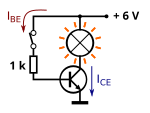Transistor as a switch
Transistors are commonly used as electronic switches, both for high-power applications such as switched-mode power supplies and for low-power applications such as logic gates.In a grounded-emitter transistor circuit, such as the light-switch circuit shown, as the base voltage rises the base and collector current rise exponentially, and the collector voltage drops because of the collector load resistor. The relevant equations:
- VRC = ICE × RC, the voltage across the load (the lamp with resistance RC)
- VRC + VCE = VCC, the supply voltage shown as 6V

No comments:
Post a Comment